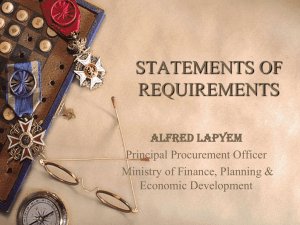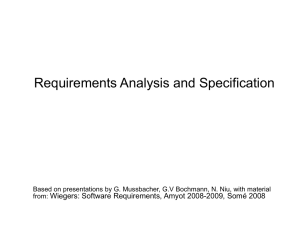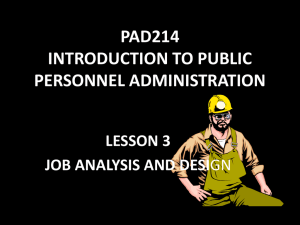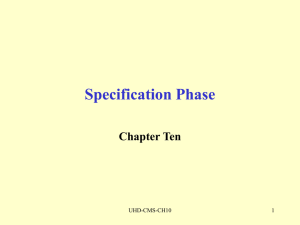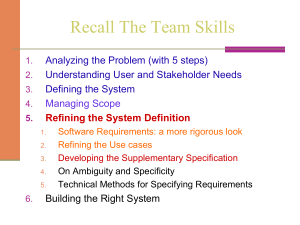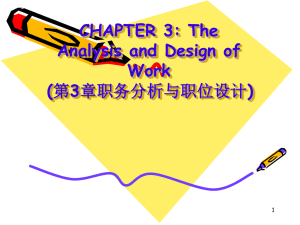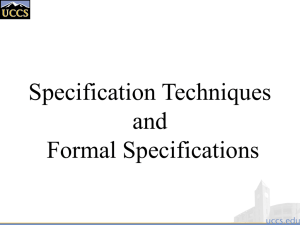CS3773 Software Engineering
advertisement
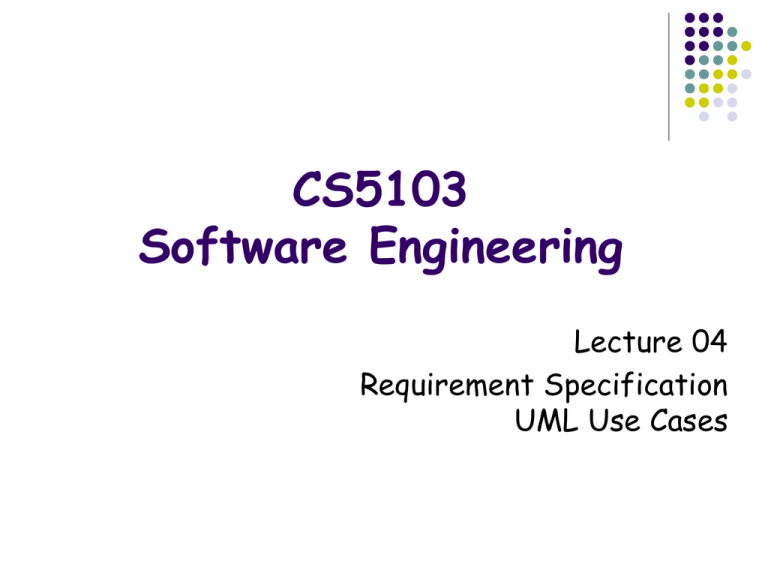
CS5103 Software Engineering Lecture 04 Requirement Specification UML Use Cases Last class Requirement Engineering 2 Concepts Definition Stakeholders Types of requirements Process Elicitation Analysis Specification Validation Elicitation Approaches 3 Brainstorming Interviewing Ethnography Strawman/Prototype Testable User Story Today’s class Requirement Engineering Analysis Specification Validation Use case diagram 4 A good notation for requirement specification Combination of different approaches Brainstorm + interview Interview + strawman/prototype Asking people after observing their work Prototype + ethnography 5 Talk to interviewee with a strawman/prototype Interview + ethnography Raise some questions, then ask more people Observe how people work on a prototype Requirements Engineering Process Elicitation Analysis Specification Validation 6 Requirements Analysis Requirements analysts have to understand the system from each stakeholder's point of view 7 Stakeholders have different views of the system Requirements analysts resolve conflicting views Requirements analysts prioritize requirements Essential requirements Desirable requirements Optional requirements Requirements Analysis Goal Categorization, negotiation, and decision: Determine the scope of the software Few established fixed approaches Large amount of mental work based on domain knowledge Project manager/customer representative often plays the key role 8 Requirements Specification Specify requirements Document what is required of the system to be developed State the requirements from the perspective of the developers 9 May be a formal document (IEEE-SRS) Requirements Specification Natural Language Specification Structure Specification Graph Notation Specification Mathematical Specification Formal 10 Natural language specification The requirements are written using numbered sentences in natural language. Each sentence should express one requirement. Diagrams and tables can be used for better understanding of the specification 11 Guidelines for writing requirements Formatting Invent a standard format and use it for all requirements Font, size, indentation, … Use text highlighting to identify key parts of the requirement. Wording Use language in a consistent way. E.g. always use shall for mandatory requirements, should for desirable requirements Avoid the use of computer jargon Including a list of term definitions Guidelines for writing requirements Contents Avoid ambiguity in expression Add as much details as you can (think as a developer) An example of natural language specification 1.1 If sales for current month are below target sales, then report is to be printed, unless difference between target sales and actual sales for the current month is under 5% Any problems with this specification? An example of natural language specification 1.1 If sales for current month are below target sales, then report is to be printed, unless difference between target sales and actual sales for the current month is under 5% Any problems with this specification? Ambiguity: 5% of actual sales or target sales? An example of natural language specification 1.1 If sales for current month are below target sales, then report is to be printed, unless difference between target sales and actual sales for the current month is under 5% Any problems with this specification? Potential term inconsistency: sales & actual sales An example of natural language specification 1.1 If sales for current month are below target sales, then report is to be printed, unless difference between target sales and actual sales for the current month is under 5% Any problems with this specification? Lack of details: What are contents in the report? When and how to print? An example of natural language specification 1.1 If sales for current month are below target sales, then report is to be printed, unless difference between target sales and actual sales for the current month is under 5% Any problems with this specification? Terms require definition: Actual sales, target sales, current month Advantages of Natural Language Expressive, can express almost any concepts, although not precisely Can be understood by users, customers, developers, etc. Easy to write Problems with natural language Ambiguity, imprecision Contradictions can happen Functional and non-functional requirements tend to be mixed-up Several different requirements may be expressed together Requirements Specification Natural Language Specification Structure Specification Graph Notation Specification Mathematical Specification Formal 21 Structured specifications The structure of a requirement is predefined The freedom of the requirements writer is limited Some common structures: Forms Tables Chapter 4 Requirements engineering 22 Form-based specifications Definition Definition of the function or entity Description of the action to be taken Input & Output Description of inputs and where they come from. Description of outputs and where they go to Pre and post conditions (if any) Dependencies Information needed & other entities used The side effects (if any) of the function E.g., reduced credit score when you query it Example: Insulin pump for blood sugar control Chapter 4 Requirements engineering 24 Example: Insulin Pump Chapter 4 Requirements engineering 25 Tabular specification A map from inputs to outputs in the form of a table Each line corresponds to a case in inputs The corresponding action is filled in Particularly useful when you have to define a number of possible alternative courses of action. Example: Insulin Pump Condition Action Sugar level falling (r2 < r1) CompDose = 0 Sugar level stable (r2 = r1) CompDose = 0 Sugar level increasing and rate of CompDose = 0 increase decreasing ((r2 – r1) < (r1 – r0)) Sugar level increasing and rate of CompDose = increase stable or increasing round ((r2 – r1)/4) ((r2 – r1) ≥ (r1 – r0)) If rounded result = 0 then CompDose = MinimumDose Chapter 4 Requirements engineering 27 Pros & Cons: structures Pros Easier to control quality compared with pure natural language Still easy to write and understand Reduce imprecision and missing of details Cons The form of structure has strong impact on the quality of specification, and is not easy to design Less expressiveness due to the rigid structures Still has the problem of natural language expression, such as ambiguity, missing term definitions, etc. Requirements Specification Natural Language Specification Structure Specification Graph Notation Specification Mathematical Specification Formal 29 Graph Notation Specification Predefined Graphical models Supplemented by text annotations Existing techniques: 30 UML: Use case diagram Widely used: we will introduce later Requirements Specification Natural Language Specification Structure Specification Graph Notation Specification Mathematical Specification Formal 31 Mathematic Specification Write specification using predefined formal languages Define all concepts, inputs, and corresponding outputs /actions formally Some popular specification languages: Z language Alloy … Example: word split with Z language Textual Description Purpose: Breaking a text into words A text is a sequence of characters. Certain characters are blanks: spaces, line breaks, and tabs A word is a sequence of non-blank characters A separator is a sequence of blank characters. Example: word split with Z language Concept Definition: char == [CHAR] (CHAR is defined as all characters) blank == [space, line break, tab] TEXT == seq char (seq is a predefined function, meaning a sequence of elements from its set-type argument) SEPARATOR == seq1 blank WORD == seq1 (char \ blank) Note: TEXT includes the empty sequence, but SPACE and WORD must have at least one character, so we declare them to be seq1 (non-empty sequences). Example: word split with Z language Requirement of function words words: TEXT -> seq WORD \forall s: SPACE; w: WORD; l,r: TEXT words <> = <> & words s = <> & words w = < w > & words (sr) = words r & words (ls) = words l & words (lsr) = words l + words r Pros & Cons Pros Precise, little ambiguity (almost pseudo code) Computer readable, so correctness can be checked with automatic tools (e.g. model checker) Easy to write test case based on the specification (providing oracles) Cons Hard to understand Hard to write, costly to find people writing it and using it Expressiveness depending on the specification language (often not expressive enough) In practice Natural language Structure Often used as a supplement to natural language Graph Notation Widely used, especially for small projects Widely used in industry, business information systems Mathematics What software often involves mathematical specification? Compilers (programming language) Browsers (HTML) Database systems (SQL) Today’s class Requirement Engineering Specification Validation Use case diagram 38 A good notation for requirement specification Requirements validation Concerned with demonstrating that the requirements define the system that the customer really wants. Requirements error costs are high so validation is very important Fixing a requirements error after delivery may cost up to 100 times the cost of fixing an implementation error. 39 Requirements Validation 40 Validation can be done with techniques Review Prototype Writing test cases Verification of properties Requirements validation techniques Requirements reviews Systematic manual analysis of the requirements Regular reviews should be held while the requirements definition is being formulated Both client and contractor staff should be involved in reviews Reviews may be formal (with completed documents) or informal 41 Requirements validation techniques Prototyping Using an executable model of the system to check requirements. Covered in previous lectures Test-case generation Developing tests for requirements to check testability Used in extreme programming, also used as a validation technique 42 Specification Verification Verification can be done with techniques Consistency checking Completeness checking 43 No contradictions All concepts are well defined Formal verification of the above or other properties Usually require mathematical specification Model checking, automatic reasoning, … History of UML UML appeared in 1997 after many years of modeling war: 50+ modeling languages Three leading languages Booch, OMT, OOSE 1994 Rumbaugh (OMT) joined Booch (in Rational) 1995 Rational bought Objectory Jacobson, OOSE -- use cases UML = OMT + Booch + OOSE + … Introduction UML is a set of modeling notations, which include 13 diagrams Static structure of the system Class diagram Object diagram …… Dynamic behavior of the system Use case diagram Sequence diagram …… We will introduce: 46 UML Use case diagram (requirement) Class diagram (general design) Sequence diagram (detailed design) UML Use Case Diagram Used as a graphics notation for requirement engineering System: drawn as a box Actors: outside the system Use cases: inside the system Relations among use cases Actors Actors are external to the system An actor specifies a role Users that operate the system directly Other software systems or hardware pieces that interact with the system One person or thing may play many roles in relation to the system simultaneously or over time Use Cases Use cases are usages of the system Use cases capture the functional requirements Use cases provide the high-level descriptions of the system’s functionality in terms of interactions Use cases show inputs and outputs between the system and the environment Use cases are from the user’s point of view Use Case – An Example ATM system Withdraw cash Check account balance Maintain usage statistics … Legend Actor: an entity in the environment that initiates and interacts with the system Use case: usage of system a set of sequences of actions Association: relation between actor and use cases <<include>> Includes dependency: a sub use case <<extend>> Extends dependency: a subtype of use cases Initial Use Case Diagram for ATM ATM System CheckBalance * * * WithdrawCash * * Customer * TransferMoney Elaborated Use Case Diagram for ATM ATM System CheckBalance <<include>> * ValidateCustomer * * <<include>> * BankingSystem WithdrawCash * * <<include>> Customer * <<extend>> * TransferMoney PayBill CollectUsageStats * * BankManager Today’s class Requirement Engineering Natural Language Structure Graph Notation Mathematical Validation Use case diagram 54 Specification A good notation for requirement specification Next class 55 UML Use case diagram Class diagram Sequence diagram Thanks! 56

